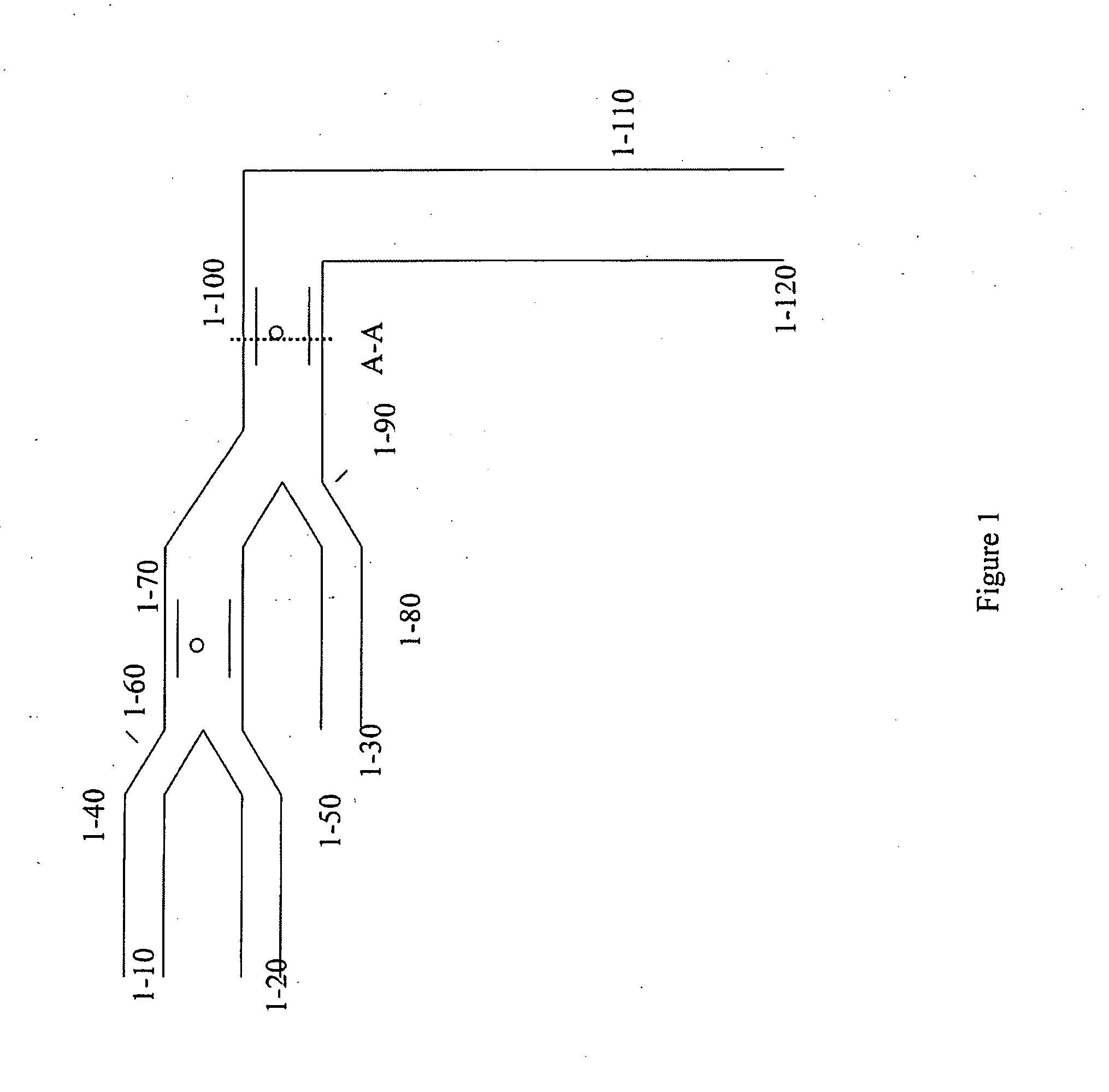Microfluidic pumps and mixers driven by induced-charge electro-osmosis
a microfluidic pump and electro-osmosis technology, applied in the field of microfluidics, micrototalanalysis systems (tas), microelectromechanical systems, can solve the problems of irreversible failure, microfluidic devices employing dc electric fields, and typically have short lifetimes
- Summary
- Abstract
- Description
- Claims
- Application Information
AI Technical Summary
Problems solved by technology
Method used
Image
Examples
example 1
Device Comprising Multiple Induced-Charge Electro-Osmotically driven Microfluidic Mixers
[0214] It is possible to create many permutations of a device comprising multiple induced-charge electro-osmotically driven microfluidic mixers or pumps, or a combination thereof, as will be appreciated by one skilled in the art, and as described hereinabove. One embodiment of such a device is a microfluidic two-stage mixer, as depicted in FIG. 1. The device will comprise inlet ports for the introduction of a sample, a reagent, a detecting moiety, a catalyst, or a combination thereof, or any agent whose introduction is desired. Such inlet ports may be constructed as depicted in the figure (1-10, 1-20, and 1-30). The inlet ports, in turn, may lead to channels (depicted at 1-40, 1-50, and 1-80 respectively, in the figure), which in this example serve to convey the introduced matter into another region of the device. Channels 1-40 and 1-50 may merge, for example as a Y-junction (1-60) and lead to a...
example 2
Analysis of Cellular Components
[0215] It will be appreciated by one skilled in the art that the device described in Example 1 may be useful in a wide array of applications. In one application, for example analysis of expressed proteins or nucleic acids in a single cell, inlet 1-10 is used to introduce a single cell in a buffer solution into the device. It will be appreciated by one skilled in the art that the inlet will be so constructed as to facilitate entry of singular cells, which are then conveyed to channel 1-40. Inlet 1-20 conveys a lysing agent. The lysing agent mixes with the cell and buffer solution in 1-70, causing cell lysis, and release of cellular contents. Inlet 1-80 conveys a fluorescent-tagged probe or antibody which mixes with the cellular contents in 1-100, resulting in specific labeling of cellular components. It is also envisioned that wash solutions are introduced in the inlet following a period of time of exposure to the labeled agent, or, another inlet which...
example 3
Construction of a Device Comprising Induced-Charge Electro-Osmotically Driven Microfluidic Mixers
[0216] Many methods for fabricating devices as described herein will be apparent to one skilled in the art. One embodiment for such a means of construction is depicted in FIG. 2. The figure specifically describes fabrication of the device outlined in Example 1, FIG. 1, at the region of the device labeled as section A-A.
[0217] The starting substrate 2-10 is a 0.5 μm thick four-inch diameter double-side polished borofloat glass wafer. Substrate 2-10 is cleaned in 3:1 sulfuric acid:hydrogen peroxide to remove any organic material from the surface. The substrate 2-10 is then oxygen plasma ashed for 5 minutes to roughen the surface.
[0218] Following preparation of the substrate, a gold layer 2-20 is e-beam evaporated onto the substrate. Polymer photoresist is deposited onto the gold layer 2-20 and patterned using a chromium photomask. The patterned photoresist is then used as a masking mate...
PUM
| Property | Measurement | Unit |
|---|---|---|
| radius | aaaaa | aaaaa |
| velocities | aaaaa | aaaaa |
| 90° angle | aaaaa | aaaaa |
Abstract
Description
Claims
Application Information
 Login to View More
Login to View More - R&D
- Intellectual Property
- Life Sciences
- Materials
- Tech Scout
- Unparalleled Data Quality
- Higher Quality Content
- 60% Fewer Hallucinations
Browse by: Latest US Patents, China's latest patents, Technical Efficacy Thesaurus, Application Domain, Technology Topic, Popular Technical Reports.
© 2025 PatSnap. All rights reserved.Legal|Privacy policy|Modern Slavery Act Transparency Statement|Sitemap|About US| Contact US: help@patsnap.com



